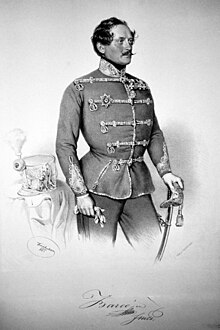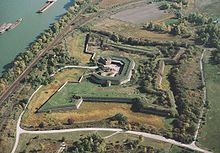Joseph of Barco
Joseph Johann Nepomuk Freiherr von Barco (born August 1, 1798 in Vienna ; † September 26, 1861 in Baden near Vienna ) was an Austrian officer ( Lieutenant Field Marshal ), Theresa Knight and the second owner of Hussar Regiment No. 3.
biography
The son of Lieutenant Colonel and Theresa Knight Felix Freiherr von Barco (* 1756 in Vienna; † October 20, 1829 in Lemberg ) joined the Kienmayer Hussar Regiment No. 8 as a lieutenant in 1813 and made the campaigns against France in 1814 and 1815 With. As a first lieutenant he performed divisional adjutant services between 1830 and 1825 before being promoted to Rittmeister in 1827 and to squadron commander of the Koburg Hussars in 1831 . On March 9, 1838 he was appointed major and in 1842 finally lieutenant colonel.
In 1844 he was promoted to colonel and commander of the regiment, to which he had been a member for 31 years since his time as a second lieutenant. In this function he prevented the seemingly inevitable bloody conflict during the threatening events in Lemberg in 1848 through his diplomatic appearance. The efforts of the subversive party to induce individual sections of the military to break loyalty were thwarted by Barco's rapid intervention. However, his behavior towards these activities put him in danger himself. Publicly posted posters called for assassinations against his life. At the end of 1848 Barco organized a land storm and brought together 80,000 men in six circles during the most tense period.
On December 1, 1848 (rank of 16th of the month) he was promoted to major general and received a mobile brigade with the task of defending the border south of Stry against Hungary. In this context there was a victorious battle at Novoselica, which should put an end to the previous frequent attacks by the enemy: An enemy column composed of almost 3,000 men from Poland under Prince Józef Woroniecki had advanced up to 600 paces against the brigade's troops, which kept the crossings at Klimetz, Wolosianka and Wyszkau occupied. Baron Barco decided to throw the enemy back before he could get reinforcements. A combined attack undertaken by nine companies, supported by a daring but well-calculated night raid, led to the complete defeat of this Polish legion on the night of March 21-22, 1849, after six hours of persistent fighting. Corporal Dobrzansky of the Hartmann Infantry saved the general's life in this fight by killing a legionnaire at the moment when the latter, only four paces from Barco, had hit him with his rifle.
In the meantime, the officer had to move the scene of his activity to Hungary himself. On his march to Kosice he had to contend with nature, with terrain obstacles and enemy attacks. After his designed with care operations against Munkács because of the number and material superiority in the enemy could not be implemented, the general marched in May 1849 Sandec after Seipusch , only to cross the Hungarian border again and jablunkov pass and the transition points at the Waag to cover. The cholera outbreak made matters worse in his brigade, which killed seven officers and 110 men within a week. Although the disease ravaged the ranks of the soldiers and Barco became infected with it himself, after he had always looked after his soldiers in the hospitals in an exemplary manner, he nevertheless dared a desperate march through the middle of the enemy lines and thus prevented the penetration of the insurgents Galicia.
In June 1849 a new Ordre de Bataille moved General Barco with 10 companies, a division of cavalry and a cavalry battery to Gutta and Keszegfalva (30 minutes from Komorn) to occupy and entrench these places. On July 11th, he attended the battle of Komorn as a volunteer . When the cholera broke out again, he asked permission to build and monitor cholera hospitals. The last time his brigade stood out was on August 3rd before Komorn, where the enemy had attempted a violent sortie with superior forces. In October 1849 he became a brigadier of the cavalry in Olomouc , with instructions to speed up the organization of the hussars.

For the deed in front of Novaselica, the baron received the Knight's Cross of the Order of Maria Theresa, later the Military Merit Cross (KD.) , The Imperial Russian Order of St. Anna 1st Class , the Imperial Russian St. Stanislaus Order 1st class , after he had previously become an officer in the Belgian Military Order of Leopold .
As a result, on November 27, 1850, he was promoted to field marshal lieutenant as a division officer in the 2nd military corps. He received renewed evidence of the benevolence of his warlord when he was appointed second owner of the hussar regiment "Prince Carl von Bayern" No. 3 in January 1857 and only two months later he was appointed Lieutenant and House Commander of the 1st Arcièren Life Guard.
Barco died single and only 63 years old as a result of intestinal complications, which were interpreted as a long-term consequence of his former cholera illness.
The cities of Opava and Tarnów honored this highly regarded general with honorary citizenship .
coat of arms
1762/1795: Squared shield with central shield. The center shield shows a warship in blue with a waving, split flag in silver on rough seas. 1 and 4 in gold a natural colored tree on a green hill. 2 and 3 in red a castle in silver with a tower, battlements and two windows underneath a red gate. The baron's crown rests on the shield. Three crowned helmets float above it. The right helmet shows an inward-looking, gold-crowned black eagle with a red-lined tongue with outstretched wings and outstretched fangs, the middle one shows a man in armor who shows a six-pointed gold star in his right hand and three flowing silver plumes from his helmet with an open visor and on the left a growing, inward-looking golden lion with a red-lipped tongue, which holds a raised sword with a golden pommel in its raised right paw. The helmet covers are blue-gold on the right and red-silver on the left.
literature
- Barcó Josef Frh. From. In: Austrian Biographical Lexicon 1815–1950 (ÖBL). Volume 1, Verlag der Österreichischen Akademie der Wissenschaften, Vienna 1957, p. 50.
- “A Colera-Cur through a Force-Ritt” in V. Streffleur's “Austrian military magazine”, VII. Vol., 4th volume, Druck- und Kommissionsverlag Carl Gerold's Sohn, Vienna 1866, p. 32 ff.
- Antonio Schmidt-Brentano: The kk or kuk generals 1816–1918, Austrian State Archives, 1907
- Military newspaper, obituary
Individual evidence
- ↑ V. Streffleur: "Austrian military magazine", 3rd issue, printed by Anton Strauss's Sel. Witwe, Vienna 1838, p. 332
- ^ A b Constant von Wurzbach: "Biographisches Lexikon des Kaiserthums Oesterreich", 11th part, Verlag der Universitätsbuchdruckerei LC Zamarski, Vienna 1856, p. 155
- ↑ a b Linzer Zeitung 1861, No. 141, 239 and 241: Nekrolog (in the features section)
- ↑ a b Militär-Zeitung of October 9, 1861, Volume 14, p. 645 f.
- ^ Wiener Zeitung of October 3, 1861, p. 3592
- ↑ Austrian Soldier Friend 1849, No. 43
- ↑ Military Schematism of the Austrian Empire, KK Hof- und Staatsdruckerei, Vienna 1851, p. 183 (appendix)
- ↑ Archived copy ( Memento of the original from March 4, 2016 in the Internet Archive ) Info: The archive link was inserted automatically and has not yet been checked. Please check the original and archive link according to the instructions and then remove this notice.
- ^ According to: JA Tyroff - " Wappenbuch der Österreichischen Monarchie ", Volume 29, Verlag Conrad Tyroffsches Wappen- , also Kunst- und Kommissionsbureau, Nürnberg 1862, T. 1
| personal data | |
|---|---|
| SURNAME | Barco, Joseph of |
| ALTERNATIVE NAMES | Barco, Joseph Johann Nepomuk Freiherr von (full name) |
| BRIEF DESCRIPTION | Austrian field marshal lieutenant |
| DATE OF BIRTH | August 1, 1798 |
| PLACE OF BIRTH | Vienna |
| DATE OF DEATH | September 26, 1861 |
| Place of death | Baden near Vienna |



